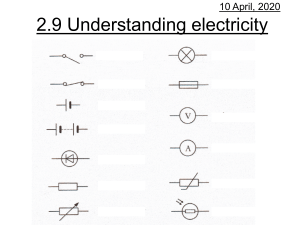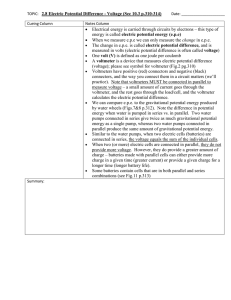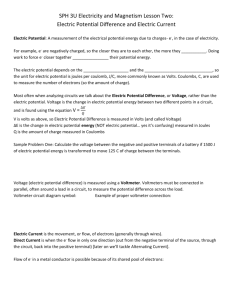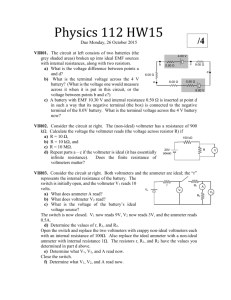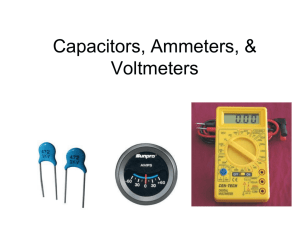University of Pitesti Dolnośląska Wyższa Szkoła Przedsiębiorczości i
advertisement
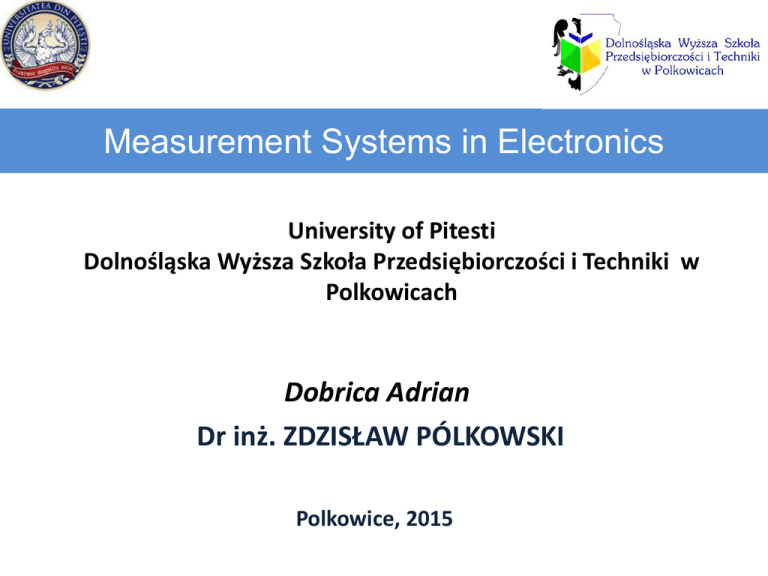
Measurement Systems in Electronics University of Pitesti Dolnośląska Wyższa Szkoła Przedsiębiorczości i Techniki w Polkowicach Dobrica Adrian Dr inż. ZDZISŁAW PÓLKOWSKI Polkowice, 2015 TOPICS MENU • • • • • • Definition Standard Electrical Units Osciloscope Operational amplifiers Voltmeter Ammeter Definition A system of measurement is a set of units of measurement which can be used to specify anything which can be measured and were historically important, regulated and defined because of trade and internal commerce. In modern systems of measurement, some quantities are designated as fundamental units, meaning all other needed units can be derived from them, whereas in the early and most historic eras, the units were given by fiat (see statutory law) by the ruling entities and were not necessarily well inter-related or selfconsistent. http://en.wikipedia.org/wiki/System_of_measurement Standard Electrical Units Electrical Parameter Measuring Unit Symbol Voltage Volt V or E Current Ampere I or i Resistance Ohm R or Ω Conductance Siemen G or ℧ Capacitance Farad C Charge Coulomb Q Inductance Henry L or H Power Watts W Impedance Ohm Z Frequency Hertz Hz http://www.electronics-tutorials.ws/dccircuits/dcp_3.html Osciloscope An oscilloscope is a laboratory instrument commonly used to display and analyze thewaveform of electronic signals. In effect, the device draws a graph of the instantaneous signal voltage as a function of time. http://whatis.techtarget.com/definition/oscilloscope General Information • A typical oscilloscope can display alternating current (AC) or pulsating direct current (DC) waveforms having a frequency as low as approximately 1 hertz (Hz) or as high as several megahertz (MHz). High-end oscilloscopes can display signals having frequencies up to several hundred gigahertz (GHz). The display is broken up into so-called horizontal divisions (hor div) and vertical divisions (vert div). Time is displayed from left to right on the horizontal scale. Instantaneous voltage appears on the vertical scale, with positive values going upward and negative values going downward. • The oldest form of oscilloscope, still used in some labs today, is known as the cathode-ray oscilloscope. It produces an image by causing a focused electron beam to travel, or sweep, in patterns across the face of a cathode ray tube (CRT). More modern oscilloscopes electronically replicate the action of the CRT using a liquid crystal display (liquid crystal display) similar to those found on notebook computers. The most sophisticated oscilloscopes employ computers to process and display waveforms. These computers can use any type of display, including CRT, LCD, and gas plasma. http://whatis.techtarget.com/definition/oscilloscope How to use Osciloscope • In any oscilloscope, the horizontal sweep is measured in seconds per division (s/div), milliseconds per division (ms/div), microseconds per division (s/div), or nanoseconds per division (ns/div). The vertical deflection is measured in volts per division (V/div), millivolts per division (mV/div), or microvolts per division (?V/div). Virtually all oscilloscopes have adjustable horizontal sweep and vertical deflection settings. • The illustration shows two common waveforms as they might appear when displayed on an oscilloscope screen. The signal on the top is a sine wave; the signal on the bottom is a ramp wave. It is apparent from this display that both signals have the same, or nearly the same,frequency.Suppose the horizontal sweep rate in this instance is 1 µs/div. Then these waves both complete a full cycle every 2 µs. If the vertical deflection is set for, say, 0.5 mV/div, then these waves both have peak-to-peak amplitudes of http://whatis.techtarget.com/definition/oscilloscope approximately 2 mV. Operational amplifiers • Operational amplifiers can be used to perform mathematical operations on voltage signals such as inversion, addition, subtraction, integration, differentiation, and multiplication by a constant. You need to understand how to figure out what an operational amplifier circuit does. We will start with a simple circuit so that we can examine a method that will permit you to figure out how these circuits work and then you will have a more general method you can use for more complex circuits. So, you have two goals in this section. http://www.facstaff.bucknell.edu/mastascu/eLessonsHTML/OpAmps/OpAmp2.html Op-amp basics • The circuit symbol for an operational amplifier consists simply of a triangle as shown below. The two inputs are designated by "+" and "-" symbols, and the output is at the opposite end of the triangle. Inputs from the "+" input appear at the output in the same phase, whereas signals present at the "-" input appear at the output inverted or 180 degrees out of phase. This gives rise to the names for the inputs. The "+" input is known as the noninverting input, while the "-" input is the inverting input. As the output from the amplifier is dependent upon the difference in voltage between the two inputs, it is known as a differential amplifier. http://www.radio-electronics.com/info/circuits/opamp_basics/operational-amplifier-basics-tutorial.php Exampe: Inverting Amplifier • The circuit we will examine is shown below. This circuit amplifies a voltage by a factor (- Ro / R1). What is important in this circuit is that it amplifies by almost exactly (-Ro /R1) so that the gain of the circuit can be controlled precisely by controlling the resistor values precisely. The gain of the circuit will not depend upon paramters of the "Op-Amp". We'll analyze this circuit to get a mathematical prediction of how it works. http://www.facstaff.bucknell.edu/mastascu/eLessonsHTML/OpAmps/OpAmp2.html Voltmeter • A voltmeter, also known as a voltage meter, is an instrument used for measuring the potential difference, or voltage, between two points in an electrical or electronic circuit. Some voltmeters are intended for use in direct current (DC) circuits; others are designed for alternating current (AC) circuits. Specialized voltmeters can measure radio frequency (RF) voltage. http://whatis.techtarget.com/definition/voltmeter Analog & Digital Voltmeter A basic analog voltmeter consists of a sensitive galvanometer (current meter) in series with a high resistance. The internal resistance of a voltmeter must be high. Otherwise it will draw significant current, and thereby disturb the operation of the circuit under test. The sensitivity of the galvanometer and the value of the series resistance determine the range of voltages that the meter can display. A digital voltmeter shows voltage directly as numerals. Some of these meters can determine voltage values to several significant figures. Practical laboratory voltmeters have maximum ranges of 1000 to 3000 volts (V). Most commercially manufactured voltmeters have several scales, increasing in powers of 10; for example, 0-1 V, 0-10 V, 0-100 V, and 0-1000 V. http://whatis.techtarget.com/definition/voltmeter Ammeter • Ammeters are a type of electronic measuring instrument that are used to evaluate the flow ofelectric current in a particular circuit. Essentially, one will measure the flow of current in terms of amperes. Various designs allow the device to be used in measuring the amount and rate of current in both small and large electrical devices. http://www.wisegeek.org/what-is-an-ammeter.htm Digital Ammeter • Digital ammeter designs use a shunt resistor to produce a calibrated voltage proportional to the current flowing. This voltage is then measured by a digital voltmeter, through use of an analog to digital converter (ADC); the digital display is calibrated to display the current through the shunt. Such instruments are generally calibrated to indicate the RMS value for a sine wave only but some designs will indicate true RMS (sometimes with limitations as to wave shape). http://en.wikipedia.org/wiki/Ammeter




